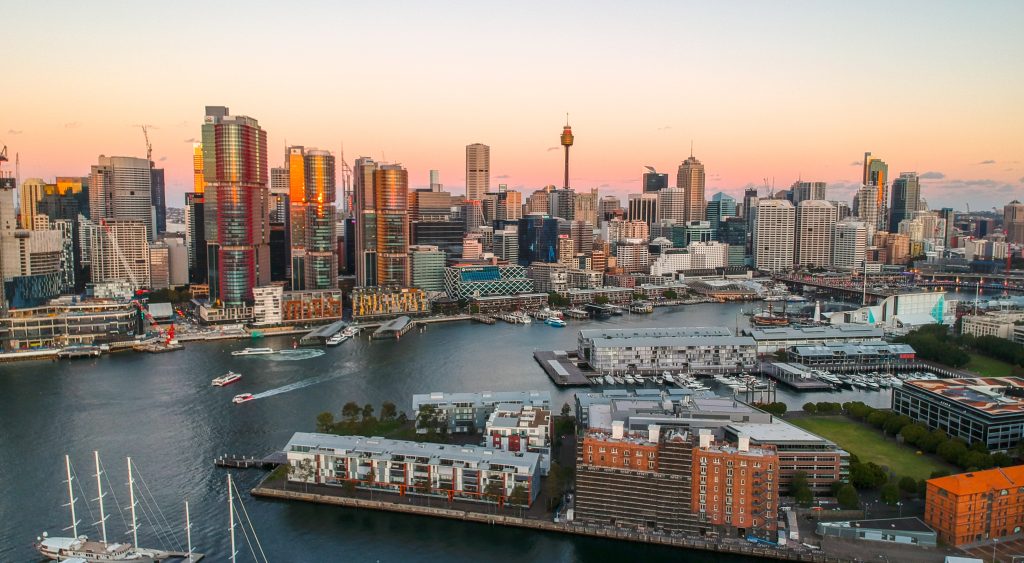Sponsorship Visa
Table of Contents
Sponsorship Visa Australia: What you need to know in 2024!

Corazon Jasa
Written: December 7, 2023
Updated: June 17, 2024
19 min read

Are you finding yourself tangled in the web of Australian visa policies, seeking a path to work down under? You’re not alone – the journey to securing a sponsorship visa in Australia can seem like navigating an intricate maze.
But what if there were signposts along the way to guide you through?
Did you know that as an employer in Australia, if you’re struggling to fill a role with local talent, sponsoring an international employee is a viable option? This route might just be your golden ticket.
Our all-encompassing guide will unravel the complexities of various sponsorship visas including eligibility criteria and application processes, making this formidable task much less daunting.
Ready for clarity on starting your Australian adventure or growing your business with global expertise? Read on – success awaits!
Key Takeaways
- Sponsorship visas in Australia let skilled workers from other countries work there.
- To get a sponsorship visa, workers must have the right skills and sometimes pass skill checks. Employers need to show they can’t find an Australian for the job.
- Some sponsorship visas can lead to living in Australia forever. Others are just for a few years but might have options to stay longer.
- Nurses, teachers, and people with jobs that are hard to fill can often get these visas.
- Knowing all about the visa you want is important. Have your skills ready and look for employers who want someone like you.
Overview of Sponsorship Visas in Australia
Sponsorship visas in Australia encompass various types, such as skilled, employer sponsored, and temporary skilled shortage visas. Sponsors and applicants must meet specific eligibility requirements for each visa type.
Types of sponsorship visas (Skilled, Employer Sponsored, Temporary Skilled Shortage, etc.)
Australia offers different kinds of sponsorship visas for people who want to work here. Each visa has its own rules and is for a specific kind of job or situation.
- Skilled Sponsored Visas: These are for workers with special skills needed in Australia. To get this visa, an Australian company must want you to work for them because of your skills.
- Employer Sponsored Visas allow Australian businesses to fill jobs with workers from other countries. This helps companies when they can’t find someone in Australia to do the job.
- Temporary Skill Shortage Visa (Subclass 482): This visa lets you live and work in Australia for up to four years if a business needs your skills for certain jobs.
- Permanent Residence Sponsorship Visas: If you work well in Australia on a temporary visa, sometimes you can stay longer and become a permanent resident.
- Designated Area Migration Agreement (DAMA) Visas: These are special agreements that let regions sponsor workers for jobs that are hard to fill locally.
Eligibility requirements for sponsors and applicants
Sponsors in Australia must meet certain requirements. They must be approved as a sponsor from the Department of Immigration, be financially stable and be lawfully operating. They must show they tried but couldn’t find an Australian citizen or someone who lives there permanently to do the skilled work they need. This is important for making sure that jobs go to Australians first when possible.
Skilled workers must have the right skills for the job. They should have the right skills for their job on Australia’s Skilled Occupation List and at least two years of recent experience in that work.
Plus, some visas like the 186 need a Skills Assessment and three years of related work experience before saying “G’day” as new workers down under. Next up, we’ll talk about employer-sponsored visas and what you should know about them!
Employer Sponsored Visas
Employer Sponsored Visas in Australia offer opportunities for employers to sponsor overseas employees, providing benefits for both parties. The requirements and procedures for subclass 482 and 186 visas are essential to understand.
Requirements and procedures for employers sponsoring overseas employees
Employers in Australia who want to sponsor overseas workers must follow certain steps. They need approval from the Department of Immigration before they can offer a job to someone from another country.
- Become an Approved Standard Business Sponsor. This means the business is allowed to sponsor employees for a visa.
- Show they are running a lawful business in Australia. The company must follow all Australian laws.
- Make sure there are no suitable Australian workers for the job first. Jobs should be offered to Australians before looking overseas.
- Agree to pay the Skilled Australians Fund (SAF) levy, which helps train local workers.
- Give details about the job, like how much it pays and what tasks it includes.
- Prove that they will pay their sponsored worker fairly.
- Make plans for what will happen when the sponsorship ends, such as if the employee will leave Australia or apply for a different visa.
Subclass 482 and 186 information
Employers and employees both enjoy advantages from sponsorship visas, and this includes those under subclass 482 and 186 as well. The Temporary Skill Shortage visa (subclass 482) lets skilled workers join Australian employers who can’t find the right skills locally.
With this visa, people can work in Australia for up to four years and bring family members along too.
The Employer Nomination Scheme (subclass 186) offers a path to live and work in Australia forever. This employer-sponsored permanent residency visa comes with two ways to enter: through direct entry or labour agreement.
For the subclass 186 visa, you must work for the sponsor who nominated you, which makes it different from the subclass 482 where renewals are allowed without limits onshore.
Requirements and DAMA
Subclass 494 and Designated Area Migration Agreement (DAMA) visas
The Subclass 494 Skilled Employer Sponsored (Regional) visa helps regional employers in Australia fill jobs they can’t with local workers. It is a way for places outside big cities to get the skilled people they need.
This visa lets overseas workers live and work in Australia for up to five years, with a chance to become permanent residents later on. Employers must follow certain rules, like picking from approved job lists and making sure foreign workers meet age limits.
Designated Area Migration Agreements or DAMA are special deals between the Australian government and specific areas. These agreements let local businesses hire skilled and not-so-skilled foreign workers when they can’t find Australians to do the jobs.
People who want these visas must speak English well enough and fit other needs set by their employer’s agreement. To use these programs, both you as an employee and your employer must understand all the steps involved.
Job Opportunities with Sponsorship Visa
Explore additional sponsorship visa options in Australia, including opportunities for childcare educators and teachers, research and administrative positions, and registered nurses.
These roles offer unique pathways for skilled professionals to secure temporary or permanent residency in the country.
Childcare educators and teachers
Childcare educators and teachers play a crucial role in the Australian workforce, and there are sponsorship visa options available for those looking to work in this field. The ANZSCO Code 241111 specifically allows for the sponsorship of Early Childhood Teachers from other countries to work in childcare in Australia.
For those considering migration to Australia, completing a teacher skills assessment through Australian Institute for Teaching and School Leadership (AITSL) is essential for fulfilling migration requirements. Additionally, skilled childcare workers have opportunities to explore sponsorship or permanent residency pathways within the country.
As an early childhood teacher or childcare educator seeking employment opportunities in Australia, it’s important to be aware of the Subclass 482 visa, which is a Temporary Skill Shortage visa requiring sponsorship from an Australian employer.
Registered nurses
Internationally qualified registered nurses can explore immigration and employment opportunities in Australia. They need to meet specific requirements depending on the visa they are applying for, such as the Skilled Independent Subclass 189 visa if not sponsored by a state/territory government or a specific employer.
Enrolled nurses, including Diploma of Nursing graduates who become Enrolled Nurses, also have options for employer-sponsored visas in Australia.
Nurses seeking to work in Australia should carefully review the eligibility criteria for different types of visas and seek guidance on the application process. With increasing demand for skilled healthcare professionals, there are promising opportunities for registered nurses looking to pursue their careers in Australia through sponsorship visas.
Engineers
The sponsored engineer must meet specific eligibility criteria, including relevant educational background, work experience, and sometimes language proficiency. Once the application is submitted, it undergoes a review by immigration authorities, who may request additional information before granting the visa. This process ensures that the engineering talent needed to drive innovation and project success is accessible to companies, fostering growth and development in the industry. Engineering positions are always in demand and a highly regarded position to bring to Australia.
Trades (Mechanics, Electricians and more)
Sponsorship visas for trades such as mechanics and other skilled labor positions play a crucial role in addressing workforce shortages in various industries.
The tradesperson must meet specific eligibility criteria, which may include relevant certifications, work experience, and sometimes language proficiency. The visa application is reviewed by immigration authorities, who may request additional documentation to ensure compliance with regulations before granting the visa.
Benefits of Sponsorship Visas for Australia
Sponsorship visas in Australia offer the opportunity for permanent residence, high demand for skilled workers in various industries, and networking opportunities through employers.
To learn more about how sponsorship visas can benefit you, keep reading!
Permanent residence opportunities
Skilled workers can be sponsored for jobs in Australia, which can potentially lead to permanent residency. Gaining Australian permanent residence offers benefits such as access to Medicare and Centrelink support.
The sponsorship visa Australia provides a pathway for skilled workers to build a future in the country through obtaining permanent residency and enjoying the benefits it brings.
This opportunity opens up new possibilities for individuals seeking long-term stability and growth, making it an attractive option for those looking to establish themselves in Australia.
High demand for skilled workers in various industries
As listed above, there is a high demand for skilled workers across diverse sectors such as healthcare, information technology, engineering, and construction.
Employers are actively seeking qualified professionals to fill crucial roles and contribute to the growth of their organisations. The Australian government’s sponsorship visa programmes aim to address this need by offering opportunities for overseas skilled workers to secure employment in these high-demand fields, benefiting both the employers and the country’s economy.
This demand not only creates job opportunities but also fosters a dynamic work environment where individuals with specific expertise can make significant contributions.
Networking and job opportunities through employers
Looking for job opportunities and networking in Australia? Getting sponsored by Australian employers opens doors to various work opportunities. Employers in Australia can sponsor individuals for skilled worker visas and other temporary visas, providing a pathway to connect with potential employers.
Networking and job opportunities are available for those looking to be sponsored by Australian employers, especially since they can directly tap into the high demand for skilled workers in various industries.
With sponsorship visas, you gain access to a network of potential employers who are actively seeking skilled workers. This opens up numerous job opportunities across different sectors, offering you a chance to secure rewarding employment in Australia.
It’s an excellent way to advance your career while contributing your skills to the Australian workforce.
Tips for a Successful Sponsorship Visa Application
Understanding the visa requirements and eligibility is crucial for a successful sponsorship visa application. Gaining relevant skills and qualifications, as well as finding a suitable sponsor and job position, are also key factors to consider.
Understanding visa requirements and eligibility
Ensure you meet the minimum qualifications and experience for your chosen visa. Your sponsor must provide accurate information, and be a Australian citizen or permanent resident. Understand specific requirements for the visa you’re applying for before starting the sponsorship application. Correct information is crucial when getting sponsored, so ensure everything is accurately presented by your sponsor.
Gaining relevant skills and qualifications
Now that you have a good understanding of the visa requirements and eligibility, it’s essential to focus on gaining relevant skills and qualifications. When applying for a sponsorship visa in Australia, having recognised qualifications, skill sets, and work experience is crucial.
In some instances, applicants may need to undergo a skills assessment to prove their proficiency at Australian standards and demonstrate their level of English proficiency as well.
It’s important to note that having evidence of recognised qualifications and relevant skills will significantly strengthen your sponsorship visa application. Whether it’s through formal education or years of hands-on experience in your field, possessing the right set of skills and qualifications can greatly enhance your chances of securing a sponsorship visa in Australia.
Finding a suitable sponsor and job position
When searching for a sponsor and job in Australia, it’s vital to strategically target positions that offer visa sponsorship. Use keywords like “Sponsor” when looking for jobs to find suitable employment opportunities with sponsorship.
Additionally, volunteering in your profession can enhance your chances of securing a sponsored job in Australia.
As you navigate through the process of finding a sponsor and job position, keep in mind that adding the keyword “Sponsor” to job roles can significantly increase your chances of finding employment opportunities with sponsorship.
Moreover, consider volunteering within your profession as this can also boost your prospects of securing a sponsored job in Australia.
Conclusion and future opportunities in Australia with a sponsorship visa
As you explore sponsorship visas in Australia, you gain valuable insights into the diverse opportunities they offer. The process is intricate but presents promising prospects for skilled workers seeking to contribute to Australia’s workforce.
Understanding the eligibility requirements and finding a suitable sponsor are pivotal steps towards securing a sponsorship visa. With diligence and preparation, embarking on this journey could lead to long-term residency and flourishing career pathways in Australia’s dynamic employment landscape.
FAQs
1. What is a sponsorship visa in Australia?
A sponsorship visa in Australia allows skilled workers to come and work temporarily when an employer offers them a job.
2. How can I get sponsored to work in Australia?
Here are some crucial questions to ask when being sponsored by an employer
- What occupation do you have?
- Does the occupation appear in the occupation list?
- Is your sponsor willing to sponsor you?
- Is the employer aware of your responsibilities?
- If yes to all questions, you can proceed with the sponsorship application.
3. Can I become a permanent resident with an Australian sponsored visa?
Yes, some Australian employer-sponsored visas may lead to permanent residence if you meet all the requirements and conditions.
4. How much does it cost to apply for a sponsorship visa in Australia?
The cost of applying for a sponsorship visa varies based on the type of visa; you’ll need to check the latest fees for your specific Australian temporary work or permanent residence application.
5. Is there a way my family can join me in Australia on my work sponsorship?
Sure, with an Australian family sponsorship visa, your close relatives might be able to live with you while you’re working in Australia.
CJMigration
CJMigration is a well-respected Sydney migration agency with over 30 years of experience in the industry. We can help guide you through the process and achieve your immigration goals.
Related Articles

Financial Requirements for Sponsors: Your Ultimate Guide 2024!

Sponsorship Visa for Hospitality Industry: Quick, Crucial Guide for 2024

